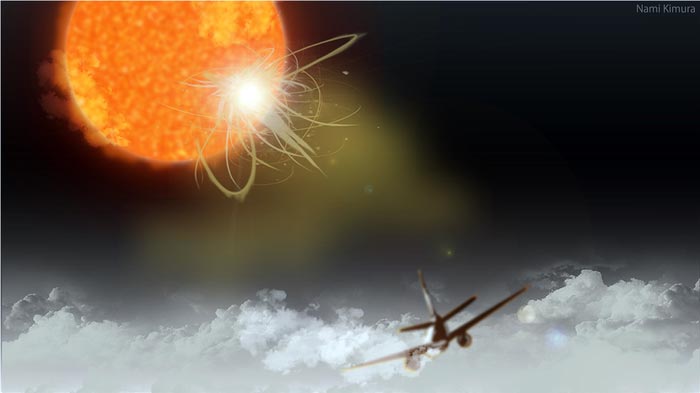

A recent study suggests that airline travel may not carry as much radiation risk as previously conjectured.
Credit: Nami Kimura/Kyoto University
Risk from solar flares to planes is real but not worth costly mitigation.
“Don’t fly too close to the sun,” said Daedalus to Icarus. Flying too high would melt the wax in his wings, while going too low would cause the sea’s moisture to create drag.
Commercial flight crews do not usually appear in Greek mythology, but they have to work with the occupational hazard of aviation radiation exposure.
Aviation guidelines aim to mitigate the effects of radiation, mainly caused by galactic cosmic rays and solar energetic particles, or SEP. The fluxes in the former are stable and predictable: dose rates are no higher than 10 µSv/h at the normal flight altitude of 12 km.
But in the case of SEP, does the frequency of detected solar flares justify the costs of countermeasures? Current mitigation procedures instruct planes to lower altitude or change or cancel flight paths altogether, significantly raising expenses.
A research team led by Kyoto University’s Yosuke Yamashiki set out to answer this question by assessing eight flight routes during five ground level enhancements, or GLE: unpredicted radiation spikes recorded by ground-based detectors.
“During a large solar particle event we see sudden SEP fluxes with dose rates exceeding 2 mSv/h,” says Yamashiki, “but these are rare and short-lived.”
Writing in the journal Scientific Reports, the researchers estimate that the maximum flight route dose and dose rate arising from major GLE events would need to exceed 1.0 mSv and 80 µSv/h, respectively, for countermeasures to be deemed necessary.
However, annual frequency estimates of GLE events of that magnitude came to only once every 47 and 17 years for maximum dose and dose rate.
So do the risks justify the costs?
“There is no denying the potentially debilitating effects of radiation exposure,” continues Yamashiki, “but the data suggest that current measures may be over-compensating for the actual risks.”
The paper “Probabilistic Risk Assessment of Solar Particle Events Considering the Cost of Countermeasures to Reduce the Aviation Radiation Dose” appeared 2 September 2021 in the journal Scientific Reports, with doi: 10.1038/s41598-021-95235-9
About Kyoto University
Kyoto University is one of Japan and Asia’s premier research institutions, founded in 1897 and responsible for producing numerous Nobel laureates and winners of other prestigious international prizes. A broad curriculum across the arts and sciences at both undergraduate and graduate levels is complemented by numerous research centers, as well as facilities and offices around Japan and the world. For more information please see: http://www.kyoto-u.ac.jp/en
Journal: Scientific Reports
DOI: 10.1038/s41598-021-95235-9
Method of Research: Meta-analysis
Subject of Research: Not applicable
Article Title: Probabilistic Risk Assessment of Solar Particle Events Considering the Cost of Countermeasures to Reduce the Aviation Radiation Dose
Article Publication Date: 1-Sep-2021
Media Contact
Jake Tobiyama












